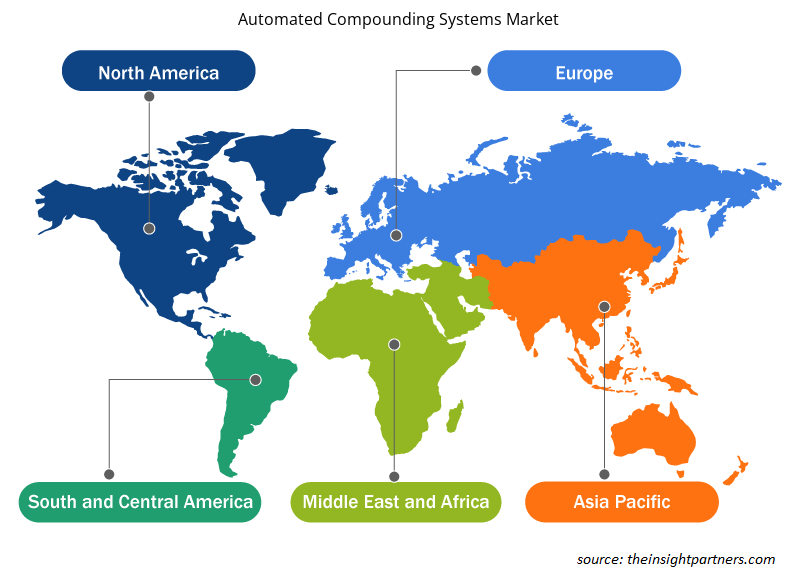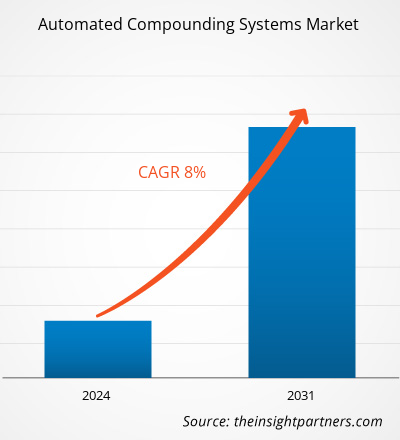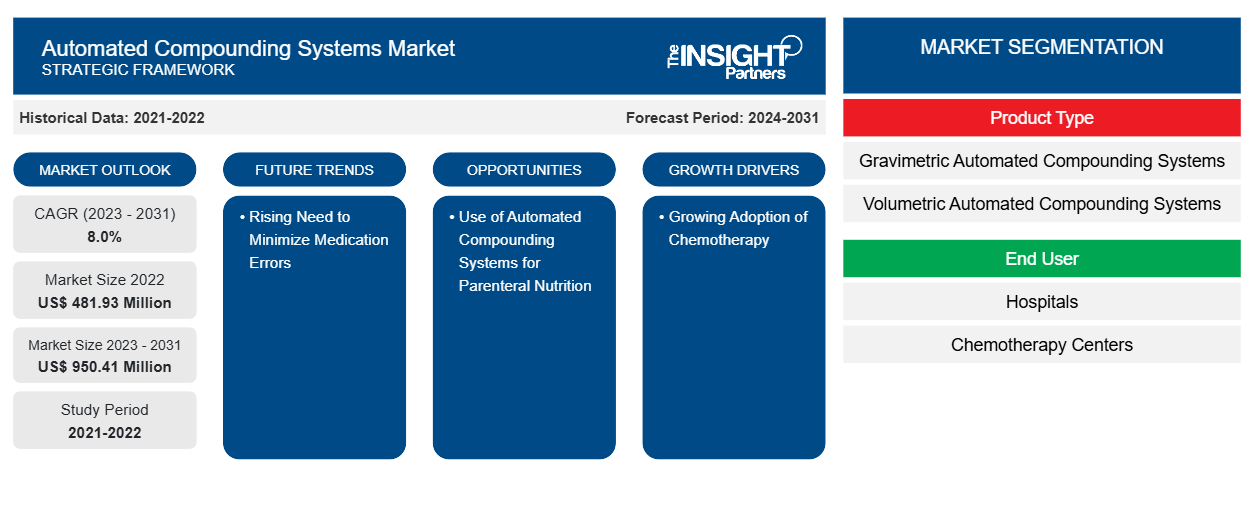El tamaño del mercado de sistemas de compuestos automatizados se estimó en US$ 481,93 millones en 2022 y US$ XX millones en 2023 y se espera que alcance los US$ 950,41 millones para 2031; se estima que registrará una CAGR del 8,0% hasta 2031. Es probable que los desarrollos estratégicos y los lanzamientos de productos sigan siendo tendencias clave del mercado de sistemas de compuestos automatizados.
Análisis del mercado de sistemas de preparación de compuestos automatizados
La creciente demanda de medicamentos personalizados, la mejora de la seguridad de los pacientes, las estrictas normas para la preparación de medicamentos, la eficiencia y la rentabilidad de los sistemas de preparación automatizados y la creciente concienciación de los farmacéuticos están impulsando el crecimiento del mercado de sistemas de preparación automatizados. Además, el aumento de la prevalencia de enfermedades crónicas ha impulsado la demanda de sistemas de preparación automatizados.
Descripción general del mercado de sistemas de preparación de compuestos automatizados
Los sistemas de preparación automática de medicamentos ayudan a evitar errores en la medicación que se producen debido a diversos factores, como la mala comunicación entre el médico y el farmacéutico, las prácticas de almacenamiento críticas en las farmacias y la confusión que surgía del uso de etiquetas similares. Además, con los sistemas de preparación automática de medicamentos, la precisión y la eficiencia de la dispensación de productos preparados han mejorado y se ha reducido aún más la exposición de los profesionales sanitarios a agentes tóxicos.
Personalice este informe según sus necesidades
Obtendrá personalización en cualquier informe, sin cargo, incluidas partes de este informe o análisis a nivel de país, paquete de datos de Excel, así como también grandes ofertas y descuentos para empresas emergentes y universidades.
-
Obtenga las principales tendencias clave del mercado de este informe.Esta muestra GRATUITA incluirá análisis de datos, desde tendencias del mercado hasta estimaciones y pronósticos.
Impulsores y oportunidades del mercado de sistemas de preparación de compuestos automatizados
Creciente necesidad de minimizar los errores de medicación
Los errores de medicación y dispensación son los principales problemas de reingreso hospitalario en todo el mundo. Los errores de medicación pueden ocurrir tanto por parte del personal médico como paramédico en numerosos niveles de atención al paciente. Un error de medicación puede ocurrir debido a varios factores, como una mala comunicación de pedidos entre el médico y el farmacéutico, prácticas de almacenamiento peligrosas en las farmacias y malentendidos que surgen debido al uso de las mismas etiquetas. Por lo tanto, la monitorización multinivel es obligatoria. Los sistemas de preparación automática se consideran una de las soluciones más calificadas para disminuir estos errores. Varias organizaciones gubernamentales están trabajando en las medidas para evitar errores de medicación y desarrollando métodos y sistemas para superar estos errores con el fin de proporcionar la medicación adecuada a los pacientes. Por lo tanto, para minimizar los errores de medicación y preparación, los gobiernos de varias naciones están fomentando el uso de herramientas de preparación y medicación automatizadas en farmacias y hospitales. Esto se considera un factor importante que impulsa el crecimiento del mercado de sistemas de preparación automática.readmissions across the world. Medication errors can happen by both medical and paramedical personnel at numerous levels of patient care. A medication error can happen due to several factors such as poor order communication between the doctor and pharmacist, hazardous storage practices in drugstores, and misunderstanding raised due to the usage of the same labels. Hence, multilevel monitoring is compulsory. Automated compounding systems are deliberated to be one of the most qualified solutions to diminish these errors. Various government organizations are working on the measures to avoid medication errors and developing methods and systems to overcome these errors in order to provide proper medication to the patients. Thus, to minimize medication and compounding errors, governments in several nations are encouraging the use of automated compounding and medication tools in pharmacies and hospitals. This is considered to be a major factor propelling the growth of automated compounding systems market.
Uso de sistemas automatizados de preparación de compuestos para nutrición parenteral: una oportunidad para el mercado de sistemas automatizados de preparación de compuestosParenteral Nutrition – An Opportunity of Automated Compounding Systems Market
La nutrición parenteral está indicada cuando los pacientes no pueden satisfacer sus nutrition is indicated when patients cannot meet their necesidades nutricionales debido a enfermedades, como el cáncer y las enfermedades crónicas que afectan al tracto gastrointestinal. Este tipo de nutrición es la piedra angular de la terapia para la mayoría de los pacientes con síndrome del intestino corto (SIC) grave. El SIC se presenta en aproximadamente 3 por cada millón de personas al año. Según el artículo titulado "Entender el síndrome del intestino corto: estado actual y perspectivas futuras", publicado en 2020, la prevalencia del SIC se ha duplicado en los últimos 40 años. La prevalencia fue de aproximadamente 30 casos por millón en los EE. UU. y aproximadamente 1,4 casos por millón en Europa. Los sistemas de preparación automática se pueden utilizar para fabricar productos de nutrición parenteral. Los sistemas de preparación automática suelen estar vinculados a un software dedicado que transfiere electrónicamente información sobre las formulaciones de NP. Varios investigadores están comparando las formulaciones de NP preparadas por sistemas de preparación automática y por métodos manuales. Se espera que las investigaciones en curso sobre el uso de sistemas de preparación automática para la formulación de NP creen oportunidades para el crecimiento del mercado de sistemas de preparación automática.SBS). SBS occurs in ~3 per 1 million people yearly. As per the article titled “Understanding Short Bowel Syndrome: Current Status and Future Perspectives," published in 2020, the prevalence of SBS has increased by more than twofold in the last 40 years. The prevalence was ~30 cases per million in the US and approximately 1.4 cases per million in Europe. Automated compounding systems can be used to manufacture parenteral nutrition products. The automated compounding systems is usually linked to dedicated software that electronically transfers information about PN formulations. A number of researchers are comparing the PN formulations prepared by automated compounding systems and by manual methods. The ongoing researches for use of automated compounding systems for formulation of PN is expected to create opportunity for growth of automated compounding systems market.
Análisis de segmentación del informe de mercado de sistemas de preparación de compuestos automatizados
Los segmentos clave que contribuyeron a la derivación del análisis del mercado de sistemas de compuestos automatizados son la vía de administración, la aplicación y el usuario final.
- Según el tipo de producto, el mercado de sistemas de preparación de compuestos automatizados se segmenta en sistemas de preparación de compuestos automatizados gravimétricos y sistemas de preparación de compuestos automatizados volumétricos. El segmento de sistemas de preparación de compuestos automatizados gravimétricos tuvo la mayor participación de mercado en 2023.
- Por usuario final, el mercado de sistemas de preparación de compuestos automatizados se segmenta en hospitales, centros de quimioterapia y otros. El segmento de hospitales tuvo la mayor participación de mercado en 2023.
Análisis de la cuota de mercado de los sistemas de preparación de compuestos automatizados por geografía
El alcance geográfico del informe de mercado de sistemas de compuestos automatizados se divide principalmente en cinco regiones: América del Norte, Asia Pacífico, Europa, Medio Oriente y África, y América del Sur y Central.
América del Norte ha dominado el mercado de sistemas de preparación de compuestos automatizados. El crecimiento del mercado en América del Norte se caracteriza por una mayor demanda de medicamentos para enfermedades crónicas, la presencia de actores clave del mercado, un aumento en los lanzamientos de productos, como la creciente adopción de sistemas de preparación de compuestos automatizados en los EE. UU., el aumento de la producción farmacéutica, que está generando una mayor demanda de llenado y envasado automatizados de medicamentos, y una amplia I+D realizada por institutos académicos y de investigación y empresas farmacéuticas. Además, se prevé que Asia Pacífico registre la CAGR más alta en los próximos años.
Perspectivas regionales del mercado de sistemas de preparación de compuestos automatizados
Los analistas de Insight Partners explicaron en detalle las tendencias y los factores regionales que influyen en el mercado de sistemas de preparación de compuestos automatizados durante el período de pronóstico. Esta sección también analiza los segmentos y la geografía del mercado de sistemas de preparación de compuestos automatizados en América del Norte, Europa, Asia Pacífico, Oriente Medio y África, y América del Sur y Central.

- Obtenga datos regionales específicos para el mercado de sistemas de preparación de compuestos automatizados
Alcance del informe de mercado de sistemas de preparación de compuestos automatizados
| Atributo del informe | Detalles |
|---|---|
| Tamaño del mercado en 2022 | US$ 481,93 millones |
| Tamaño del mercado en 2031 | US$ 950,41 millones |
| CAGR global (2023 - 2031) | 8.0% |
| Datos históricos | 2021-2022 |
| Período de pronóstico | 2024-2031 |
| Segmentos cubiertos |
Por tipo de producto
|
| Regiones y países cubiertos |
América del norte
|
| Líderes del mercado y perfiles de empresas clave |
|
Densidad de actores del mercado de sistemas de preparación de compuestos automatizados: comprensión de su impacto en la dinámica empresarial
El mercado de sistemas de preparación de compuestos automatizados está creciendo rápidamente, impulsado por la creciente demanda de los usuarios finales debido a factores como la evolución de las preferencias de los consumidores, los avances tecnológicos y una mayor conciencia de los beneficios del producto. A medida que aumenta la demanda, las empresas amplían sus ofertas, innovan para satisfacer las necesidades de los consumidores y aprovechan las tendencias emergentes, lo que impulsa aún más el crecimiento del mercado.
La densidad de actores del mercado se refiere a la distribución de las empresas o firmas que operan dentro de un mercado o industria en particular. Indica cuántos competidores (actores del mercado) están presentes en un espacio de mercado determinado en relación con su tamaño o valor total de mercado.
Las principales empresas que operan en el mercado de sistemas de preparación de compuestos automatizados son:
- Simplicidad
- Baxter Internacional Inc.
- Braun Melsungen AG
- Comedor
- UCI MEDICA INC
- Grifols, SA
Descargo de responsabilidad : Las empresas enumeradas anteriormente no están clasificadas en ningún orden particular.

- Obtenga una descripción general de los principales actores clave del mercado de sistemas de compuestos automatizados
Noticias del mercado de sistemas de preparación de compuestos automatizados y desarrollos recientes
El mercado de sistemas de preparación de compuestos automatizados se evalúa mediante la recopilación de datos cualitativos y cuantitativos posteriores a la investigación primaria y secundaria, que incluye publicaciones corporativas importantes, datos de asociaciones y bases de datos. A continuación, se incluye una lista de los avances en el mercado de sistemas y estrategias de preparación de compuestos automatizados:
- Simplivia lanzó la innovadora solución de automatización de quimio SmartCompounders, impulsada por el dispositivo líder de transferencia de fármacos de sistema cerrado (CSTD) Chemfort. Proporciona a los farmacéuticos y técnicos las herramientas para hacer que el proceso de preparación sea más corto, más confiable y elimine errores en la identificación de medicamentos y la cantidad de dosis. (Fuente: Simplivia, sitio web de la empresa, 2024)
- Baxter International Inc lanzó el mezclador automatizado ExactaMix Pro. ExactaMix Pro combina una seguridad mejorada con funciones más intuitivas y eficientes y una mayor potencia de procesamiento en comparación con ExactaMix. (Fuente: Baxter, sitio web de la empresa, 2022)
Informe de mercado sobre sistemas de preparación de compuestos automatizados: cobertura y resultados
El informe “Tamaño y pronóstico del mercado de sistemas de preparación de compuestos automatizados (2021-2031)” proporciona un análisis detallado del mercado que cubre las siguientes áreas:
- Tamaño del mercado y pronóstico a nivel global, regional y nacional para todos los segmentos clave del mercado cubiertos bajo el alcance
- Dinámica del mercado, como impulsores, restricciones y oportunidades clave
- Principales tendencias futuras
- Análisis detallado de las cinco fuerzas de Porter y PEST y FODA
- Análisis del mercado global y regional que cubre las tendencias clave del mercado, los principales actores, las regulaciones y los desarrollos recientes del mercado.
- Análisis del panorama de la industria y de la competencia que abarca la concentración del mercado, el análisis de mapas de calor, los actores destacados y los desarrollos recientes
- Perfiles detallados de empresas
- Análisis histórico (2 años), año base, pronóstico (7 años) con CAGR
- Análisis PEST y FODA
- Tamaño del mercado, valor/volumen: global, regional y nacional
- Industria y panorama competitivo
- Conjunto de datos de Excel
Informes recientes
Testimonios
Razón para comprar
- Toma de decisiones informada
- Comprensión de la dinámica del mercado
- Análisis competitivo
- Información sobre clientes
- Pronósticos del mercado
- Mitigación de riesgos
- Planificación estratégica
- Justificación de la inversión
- Identificación de mercados emergentes
- Mejora de las estrategias de marketing
- Impulso de la eficiencia operativa
- Alineación con las tendencias regulatorias























 Obtenga una muestra gratuita para - Mercado de sistemas de compuestos automatizados
Obtenga una muestra gratuita para - Mercado de sistemas de compuestos automatizados